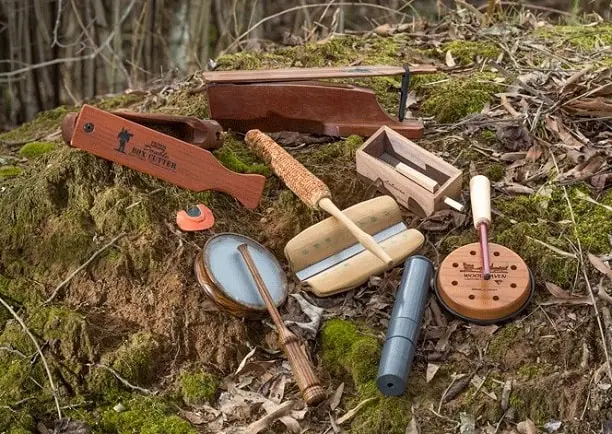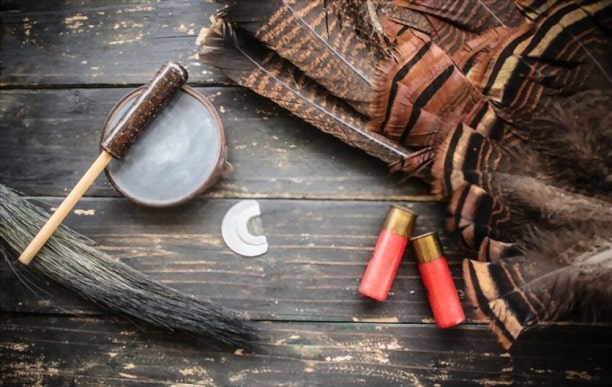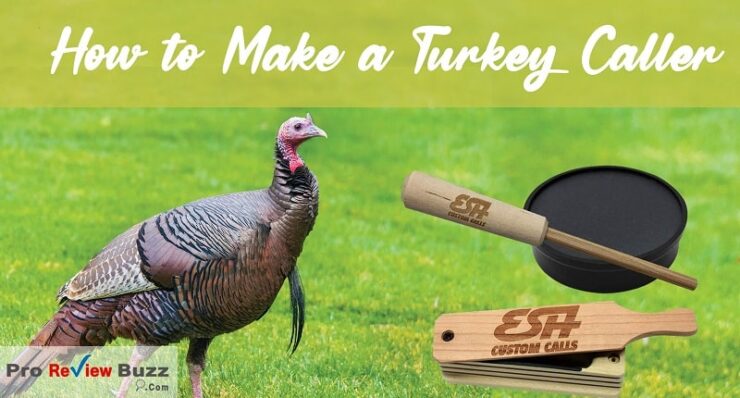It takes a lot of experience for one to able to call turkeys, the type of practice that irritates people who don’t appreciate stuff like the sound of a perfect yelp or even how a piece of roughed up glass and a stick will help you to communicate with a wild animal
Why would one need to make a turkey caller?
The Wild turkeys have been known to communicate with each other using the language of yelps, putts, gobbles, purrs, and other sounds. And because of that, the hunters have come up with devices that can be used to mimic these sounds and thus lure turkeys within firing range. The device is called the turkey callers and they are found in stores and online vendors, but as much as they can be found on these platforms, many hunters choose to create their own.
You might be wondering.
Why will anybody make turkey calls at home while they can be purchased online or at any goods store? For beginners, it gives you the satisfaction of making your own turkey caller. It would also save you money in certain situations (if you already have the equipment) and is a necessary skill for someone who is self-dependent. With a turkey caller on your hand, you are gonna enjoy your winter months.
6 TYPES OF TURKEY CALLS

Before we get into how to make fantastic turkey callers, it’s a good idea to first hear about the different kinds of calls you can make. Here are with me six traditional turkey calls that may interest you, let us look at them.
Push-button Calls
The friction that exists between two pieces of wood grinding together produces sound in a push-button call. The caller presses either up or down on a spring-loaded wooden dowel that is fixed to a block of wood. The wooden block rubs against a pyramid-shaped piece of wood fixed to the bottom of the call box, producing various sound effects based on the speed with which the dowel is pressed. Push-button calls are well-known for their simplicity. Most of the experienced hunters would sometimes not use them because they think they are just for novices. For sure they may be easy, but their efficacy does not suffer as a result.
Slate Calls
This is another kind of friction-based call which is a slate call, it is also known as a pot call. This is a circular disk or “pot” that is made of ceramic, slate, or glass that is used together with a striker. The striker is made of wood, carbon, or aluminum and is used to produce various sounds when it comes into contact with the surface of the pot. The striker is scraped on the disc at different angles, speeds, and intensities to produce about every turkey sound one can possibly think of. The amount of sounds and patterns that a slate call can make is only controlled by the caller’s expertise and experience.
Locator Calls
Locator calls are very special callers that may be used to find a turkey very early in the morning when he is already on the roost, or even in the evenings to pinpoint his position inside a patch of woods or a plain. There are different kinds of methods that you can use to make more natural sounds, that is, depending on the kind of locator call you are using. What is more important with these calls is that; be in a place where you can conveniently disappear if you call and a gobbler is still within firing distance.
Diaphragm Calls
Diaphragm calls, well known also as mouth calls, are horseshoe-shaped, thin instruments that produce sound by vibrating either a rubber or latex reed. In order for this type of call to work, the caller has to blow air onto the roof of their mouth while keeping the diaphragm call steady in their mouth, in doing so, you will be contacting the reed and causing a series of vibrations. By adjusting the pressure and the direction of the air, the hunters can successfully manage to mimic every sound that a turkey produces.
Box Calls
A box call is one of the common turkey calls that are simple enough especially for beginners while being flexible enough for experts. A box call, just like a push-button call, produces sound by friction. for this tool to work, a small wooden box and a wooden lid scrape together in order to produce yelps, clucks, cuts, purrs, whines, cackles, among other sounds. Master this call and you’ll be unstoppable to a tom.
Wing Bone Calls
The original turkey calls are wing bone calls. Just as the name suggests, these calls are made from the wing bones of a turkey, which are put together to form an instrument that early hunters used to lure gobblers even before commercial calls were available. Wing bone calls are much easier to use. For the caller to make the yelp or some sequences of yelps by simply tightening the lips around the end of the wing bone and creating a puckering or kissing sound.
How To Make A Turkey Caller

If you are a turkey hunter, one of the things that you would like to know before going turkey hunting is how to make your own turkey calls. So let’s take a look at those turkey calls that you should be making.
Pill Bottle Turkey Call
Anyone who likes to hunt turkeys should make their own turkey calls. This type of turkey caller does not need any special instruments, because you already have anything you need all-around where you live. The following are the materials that you will require for you to get started with making the pill bottle turkey callers.
TOOLS YOU NEED
- Pill bottle
- Disposable latex gloves
- Rubber band
- Permanent marker
- Sharp cutting knife
- Scissors
STEPS TO FOLLOW
- For a start, make a cut at the end of your pill bottle.
- Draw a half-circle on the pill bottle’s cap and then fill it in.
- After you are done with this, cut out the half-circle of the cap of the pill bottle.
- Next, use your scissors to cut a 3×3-inch square from your latex gloves.
- You then cover the bottle using the cap making sure you spread the latex glove squares over the hole, leaving a quarter inch on the half-circles flat part. position it well using the rubber band.
- At last, the pill bottle turkey is now ready!. It is really easy to use. Hold the latex-coated cap in your hand and then bring its end to your lips, and then blast it. By doing so, you will have the ability to produce yelps, clucks, and even gobbles.
Wing Bone Turkey Call
This turkey call which has a wing bone is the best for making accurate yelps. Let’s take a look at how you can make one for yourself.
TOOLS YOU NEED
- Turkey wings
- Sharp skinning knife
- Cooking pot
- Water
- Dawn dishwashing soap
- Wire brush
- Hack saw
- Screwdriver
- Epoxy Glue
- Superglue
- Thread
STEPS TO FOLLOW
- Set aside the wings from the last gobbler. If by any chance you’ve recently captured one, you’ll have to skin it and then remove all the meat therein. A sharp knife or a razor blade is good for this job.
- using your boiling pot, let the water boil, and then let it steam for some time on low heat. When it is ready, mix the water with Borax and Dawn dishwashing liquid.
- You then put your fully defleshed turkey wing bones in a pot of simmering water for approximately an hour.
- With your hands, clean off any meat, drain your cooking pot, and add some more clean water.
- Bring the clean water which you had just put in the pot to a boil and let it simmer for a few minutes before adding the wing bones. you then leave them to boil for another hour or so inside the jar.
- Drain off the dirty water from the pot and then carefully scrub the turkey wing bones with all meat and fat using either a wire brush or a very sharp knife.
- With your hacksaw, cut gently the ends of the 3 wing bones. While doing so, be sure you’re not using too much energy that can end up breaking the bone.
- Just at the point where the bone ends, cut it carefully so that you can flame it out. When you are done, cut off the widest part of the bone.
- For you to remove all of the bone marrow, you will have to blow through the bones like a straw. Use a screwdriver to extract all of the marrow from larger bones.
- With the bones ready, join them from end to end with a lot of care. This process will be well if the largest portion of the small bone would be attached to the smallest part of the medium bone. The most important part in joining the two bones is that the largest bone should blend into the smallest part of the big bone. Sharpen the ends of the bones with your knife until they fit together better.
- Seal the bones permanently with your epoxy glue and fill up some cracks with the same glue. If you do not do this, the call will not work properly. It must be locked. And ensure you’ve sealed all of the ties as well.
- After about some ten minutes, apply the superglue and then wrap all of the joints with thread for a clean overall appearance.
Can Clucker Turkey Call
This type of turkey call is typically a homemade variation of the turkey pot call. All you will need is a striker, which you’re likely to have if either you’ve been turkey hunting or you can buy a new one in any nearby store.
TOOLS YOU NEED
- Empty chewing tobacco can
- A piece of cedar which been sanded and formed into circles to perfectly fit in the can
- Glue. A heated glue can that has glue sticks would be good.
- Drill
- Sandpaper
STEPS TO FOLLOW
- Make almost 5 holes in the can after making sure that the cap is off. With one hole in the middle, the other four should be in a square pattern equidistant from the center hole.
- For about 12 inches longer than the can, glue the well-sanded cedar. Then apply hot glue (a single bead) on the insides of the can, and while the glue cools down, force the cedar into it.
- Repeat the same process with the slate surface within the can’s lip as you will the cedar sounding board.
- Soften any of the can’s rough edges with sandpaper, and then finally add the cap.
Hand Jig Mouth Calls
If you are interested in using a special jig that is designed specifically for making turkey mouth calls, then you have the solution.
TOOLS YOU NEED
- Hand Jig (Feather Ridge Hand Jig Is mostly recommended)
- Three latex pieces for the mouth call
- Frame
- Pliers
- Scissors
- Tape
STEPS TO FOLLOW
- Put some pressure on the hand jig and then position your rubber bits between the clamps.
- After clamping the rubber bits, then remove the support.
- For the tension to be set, then a dial should be used.
- To the right-hand side, turn the jig then you grab the base, and gently bend it on the metal side.Turn the hand jig back upright.
- After removing the file, crimp the case. That would enable the frame to slide over the latex.
- Carefully fold the metal frame that’s been covered by the latex
- Reduce the clamping strain before removing the latex, so that it would result in a turkey caller that has no back tension.
- Softly draw on the latex parts behind the U-curve formation until there is a small curve in the latex, this will reduce the tension.
- With your pliers, hold the U and bend the tab a little to keep the back tension in place.
- For the metal base to be parallel with the tab, Pinch the tab with your pliers. This will reduce the stress.
- The excess latex should be trimmed with scissors. Make all the cuts you would want to make.
- Before wrapping up the frame, the tape would have created an oblong-shaped opening. Because of a strong grip, it will easily fit in the mouth. The tape and latex must not come into contact with each other.
CONCLUSION
With all these processes out of the way, you are now ready to build your own turkey caller. You should keep in mind that for a good call, you must be good too. Anyone with a keen ear stands a chance to make better callers. It is really amazing to know that real turkeys sound terrible in contrast to their human impersonators; therefore, most of the time they mistake everything they hear as another of their own. As much as the sound matches perfectly with that of the real turkey, overcalling raises suspicion with them.Therefore if you are new to calling turkeys, I hope you have learned a lot in order to improve your calling technique —and make you the best turkey caller around. with a turkey caller in your hand, it can seem difficult at first. This article is helpful in shedding light on how to quickly create your own caller.

